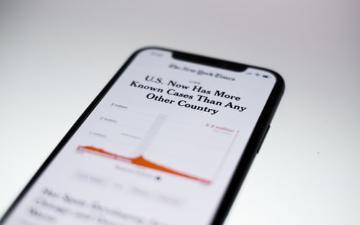
Brian McGowan/Unsplash
Anita Varma is the assistant director of Journalism and Media Ethics as well as Social Sector Ethics. Views are her own.
Conspiracy theories, propaganda, and fabricated medical claims are running rampant across media ecosystems amidst coronavirus. At the same time, subtle forms of misinformation also arise and may go unnoticed. The five examples below come not from nefarious campaigns but from earnest storytelling techniques that regularly prioritize simplicity, which is often at odds with the present complexity of coronavirus.
1. Seeking (or suggesting) a silver bullet.
Social distancing, testing, contact tracing, treatments, and vaccine development are all parts of a larger whole when it comes to addressing coronavirus and mitigating risks for the population at large. At the same time, stories that position any one of these as a silver bullet for ending the crisis oversimplify the challenge at hand.
2. Doomsday narratives that neglect to represent recovery.
The number of diagnosed cases and rising death tolls are undeniably terrifying, and reporters do us no favors by softening these numbers. Yet stories that do not also report the number of people who have recovered and successful steps to mitigate risk are distorted. Narratives that represent people who survived the illness and, in some cases, are now learning to live with chronic effects can incorporate the grave dangers at hand without suggesting that the virus is uniformly fatal.
3. Construing everyone opposed to indefinite economic shutdown as having a singular set of politics grounded in denial of the crisis at hand.
Some people oppose the continued shutdown of non-essential businesses on the basis of denying the risks of coronavirus, while others acknowledge these risks and also argue they have no possibility of survival if economic stagnation continues. In many cases, this financial reality is due to federal aid not reaching businesses in need (or not sufficing) – which is a different story from one that positions everyone opposed to ongoing shutdown as foolhardy, ignorant, or cavalier.
For a strong example of coverage that represents the complexity of business owners’ views and concerns, take a look at ABC News’ report on businesses reopening in Georgia: https://youtu.be/v0h7B6ql4tQ
4. Indexing officials’ claims – partially.
Many news reports on Dr. Fauci’s testimony to a Senate committee on May 12, 2020 offered partial accounts of senators’ questions and concerns. Comparing these news stories to the raw video, it becomes clear that the antagonism reported was in some cases exaggerated or taken out of context.
5. Quoting people with titles talking about affected communities, without directly quoting affected communities.
Elected representatives have visibility into their constituents’ lived experiences, but this does not mean that elected representatives are perfect proxies. For starters, elected representatives are unlikely to have time to connect with all communities in their jurisdiction. Stories that solely quote elected representatives may distort or ignore on-the-ground experiences.
